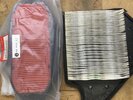The Honda maintenance schedule for the NC recommends air filter replacement at 12,000 miles. I do mine at 24,000 miles, no sooner. The NC air filter area looks very large, to me, compared to other vehicles. I compared an NC filter to a Dodge V6 3604cc engine’s air filter. The NC filter measures approximately 32 square inches, while the Dodge filter is about 48 square inches. The Dodge filter is about 1.5 times the size of the NC’s, while it’s engine displacement is over 5 times the size.
The white filter in the photo, next to the NC filter, is the Dodge filter with 24,000 miles on it.
One could argue I did not measure air flow characteristics, etc, in this comparison. This is just a visual comparison. I don’t change NC filters at 12,000 miles as I believe they are way oversize for the engine displacement.
The white filter in the photo, next to the NC filter, is the Dodge filter with 24,000 miles on it.
One could argue I did not measure air flow characteristics, etc, in this comparison. This is just a visual comparison. I don’t change NC filters at 12,000 miles as I believe they are way oversize for the engine displacement.



